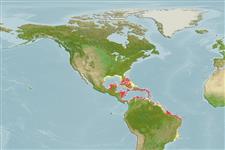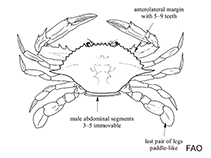Callinectes larvatus Ordway, 1863
Masked swimcrab| Native range | All suitable habitat | Point map | Year 2050 |

|
| This map was computer-generated and has not yet been reviewed. |
| Callinectes larvatus AquaMaps Data sources: GBIF OBIS |
تصوير گوگل | No image available for this species;
drawing shows typical species in Portunidae.
رده بندی / Names اسامي عام | مترادف | CoL | ITIS | WoRMS
Malacostraca | Decapoda | Portunidae
Environment: milieu / climate zone / تغييرات عمق / distribution range بوم شناسي
موجوداتی که در محدوده وسیعی از آبهای آزاد از نزدیک بستر و یا روی کف بستر، در قسمت های میان آبی تا سطح آب و در برخی گونه ها با قابلیت پرواز، زندگی و تغذیه می کنند.; تغييرات عمق 0 - 25 m (مرجع 97531), usually 0 - 5 m. Tropical
Distribution كشورها | مناطق سازمان خوار و بار جهاني (FAO) | Ecosystems | ظهور | معرفي
Western Atlantic: USA to Brazil.
Length at first maturity / Size / Weight / سن
بلوغ: Lm ? range ? - ? cm Max length : 14.2 cm WD جنس نر / بدون خواص جنسي; (مرجع 367); 9.5 cm WD (female)
توصيف مختصر ريخت شناسي
Life cycle and mating behavior بلوغ | تولید مثل | تخم ریزی | Eggs | Fecundity | Larvae
مآخذ اصلی
مراجع | هماهنگ كننده | همكاران
Tavares, M. 2003 True Crabs. pp. 327-352. In Carpenter, K.E. (ed.) The living marine resources of the Western Central Atlantic. Volume1: introdution, molluscs, crustaceans, hagfishes, sharks, batoid fishes, and chimaeras. FAO Species Identification Guide for Fishery Purposes and American Society of Ichthyologists and Herpetologists Special PublicationNo. 5. Rome, FAO. pp. 1-600. (مرجع 367)
وضعيت در فهرست قرمز IUCN
(مرجع 130435: Version 2025-1)
وضعيت از نظر سايتس (مرجع 108899)
CMS (مرجع 116361)
خطر برای انسان ها
استفاده انسانی
ماهي گيري – شيلات: ارزش تحاري اندك
| FishSource |
ابزارها
اطلاعات بيشتر
تركيب غذايي
مصرف غذايي
شکارچیان
Max. ages / sizes
Length-weight rel.
Length-length rel.
نوسانات طولی
Mass conversion
فراواني
منابع اينترنتي
BHL | BOLD Systems | CISTI | DiscoverLife | FAO(Publication : search) | Fishipedia | GenBank (ژنوم, نوکلئوتيد) | GloBI | Gomexsi | Google Books | Google Scholar | Google | PubMed | Tree of Life | Wikipedia (برو, جستجو) | Zoological Record



